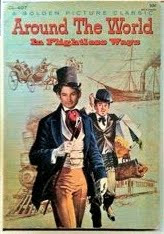It's very cold and drizzling with rain here in Olsztyn, so perfect weather to visit a museum - the Museum of Warmia and Masuria.
Copernicus lived in Olsztyn - actually in the castle that now houses the museum - for a few years in 1516-20, working in an administrative job. The museum includes paperwork from his work in which he writes about such fascinating things as dividing up some land and setting the price of bread. In his spare time he was the first person to discover the true nature of the universe, figuring out that the Earth was not the centre of the universe and that it and the other planets orbited the Sun.

Not far from Olsztyn, the Battle of Grunwald took place in 1410. This was a defining moment in Polish history, wherein Polish and Lithuanian forces led by King Jagiello defeated the Teutonic Knights. It was one of the largest battles in Europe, involving 70,000 troops. The battle is depicted in a painting by Jan Matejko in 1878 and this painting is regarded as one of the most important in Polish art history. The Museum does not hold that painting - I'll see it in Warsaw - but it is showing an exhibition of other paintings portraying the Battle of Grunwald. Some of these are commentaries on Matejko's painting while others are depict their own version of the battle.
Here is the original painting, 'Battle of Grunwald' (Bitwa pod Grunwaldem) by Jan Matejko which is nearly ten metres wide and over four metres tall:
The exhibition included a replica by Jan Rudolph which was about a quarter of the size of the original and looked to me to be unfinished. Here's a detail of Witold, grand duke of Lithuania from the replica:
Over sixty year's after the Matejko painting, in 1931 Wojciec Kossak painted another version of the battle. In his letters, Kossak explicitly states that he was attempting to surpass Matejko:
For some reason a lot of the paintings seemed to be done in the mid-1980s. Perhaps they were commissioned at that time for an exhibition. This one, 'Gry wojenne' by Elzbieta Subbotko (1985), seems a kind of cubist version of the battle/ Matejko painting:
A favourite of mine was another abstract portrayal, 'Bitwa pod Grunwalden wedlug Jana Matejki' by Tadeusz Burniewicz (1985). It's one of those paintings that when you look close up just looks like a mess but when you step back you can make out the figures. See the horses?:
Here's another asbstract, this one containing almost Pollock-like paint dribbles. 'Bez tytulu' by Marek Wrobel:
The exhibition included several photo montages by a group called Lodz Kalista who in 1999 created a kind of tableau that vaguely resembles the Matejko painting:
One painting seemed to be a mural on the wall, but since this is a traveling exhibition, I'm not sure what happens to it. It was a huge depiction of some kind of battle or crowd scene, again called 'Bitwa pod Grunwaldem' (Battle of Grunwald) by Edward Dwurnik (2010). Here is the whole thing and some details:
So there you have it: different ways artists have portrayed this important moment in Polish history. Hope you enjoyed them.





































